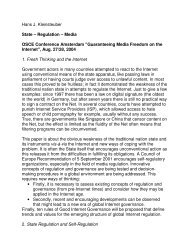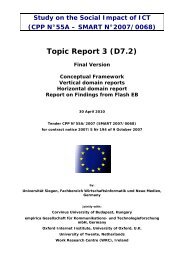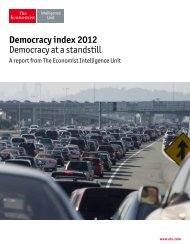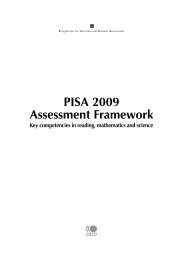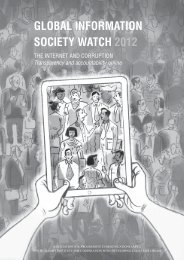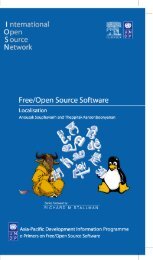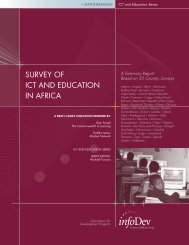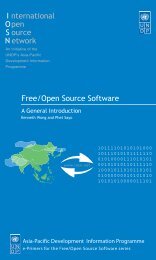Implementing broadband Internet in the classroom: key issues for ...
Implementing broadband Internet in the classroom: key issues for ...
Implementing broadband Internet in the classroom: key issues for ...
You also want an ePaper? Increase the reach of your titles
YUMPU automatically turns print PDFs into web optimized ePapers that Google loves.
Peter Birm<strong>in</strong>gham and Chris DaviesThe case <strong>for</strong> comprehensive, high-speed connectivity <strong>in</strong> schools tends to be made <strong>in</strong>broad generic terms, often regardless of <strong>the</strong> realities of considerable local variation(such as geography, technological <strong>in</strong>frastructure, etc.). The follow<strong>in</strong>g def<strong>in</strong>ition from<strong>the</strong> EU summarizes, <strong>in</strong> typical terms, <strong>the</strong> k<strong>in</strong>ds of beneficial outcome claimed <strong>for</strong><strong>the</strong> current massive global <strong>in</strong>vestment <strong>in</strong>to <strong>the</strong>se technologies: ‘e-Learn<strong>in</strong>g: <strong>the</strong> useof new multimedia technologies and <strong>the</strong> <strong>Internet</strong> to improve <strong>the</strong> quality of learn<strong>in</strong>gby facilitat<strong>in</strong>g access to resources and services as well as remote exchanges andcollaboration’ (European Commission 2001: 2).A more recent report from Cisco Systems (2002: 7) specifies <strong>in</strong> slightly more detailwhat it is about <strong>broadband</strong> technology that actually enables such outcomes:… <strong>broadband</strong> allows teachers to <strong>in</strong>corporate <strong>Internet</strong> content <strong>in</strong>to<strong>the</strong>ir lesson plans. Without <strong>broadband</strong> <strong>Internet</strong> access, teachers andstudents end up wait<strong>in</strong>g <strong>for</strong> content to download. Students get restlessand lose <strong>in</strong>terest. By deliver<strong>in</strong>g content quickly, however, <strong>broadband</strong>allows teachers to capitalize on <strong>the</strong> Web as an educational resource.Broadband also enables teachers to br<strong>in</strong>g real-time audio and video<strong>in</strong>to <strong>the</strong>ir <strong>classroom</strong>s. Ra<strong>the</strong>r than po<strong>in</strong>t to a static picture of an Africanelephant, teachers can show <strong>the</strong>se majestic animals march<strong>in</strong>g across<strong>the</strong> savannah—a far more <strong>in</strong>spir<strong>in</strong>g option, particularly to a generationweaned on video games.With<strong>in</strong> <strong>the</strong> EU and beyond, such specifically educational aspirations are also typicallyplaced <strong>in</strong> <strong>the</strong> contexts of lifelong learn<strong>in</strong>g, access to <strong>the</strong> knowledge economy and <strong>the</strong>need to ensure that, by <strong>the</strong> end of 2003, ‘all school-leavers have had <strong>the</strong> chance tobecome digitally literate’ (European Commission 2001: 3). Fur<strong>the</strong>rmore, educationalpolicy and rhetoric <strong>in</strong> <strong>the</strong> UK promotes <strong>the</strong> notion that <strong>broadband</strong> <strong>Internet</strong> specificallyencourages active and <strong>in</strong>dependent learn<strong>in</strong>g. A recent Becta (2003) report claimedthat ‘anecdotal evidence demonstrates <strong>the</strong> effectiveness of <strong>broadband</strong> <strong>in</strong> remov<strong>in</strong>gbarriers to access to ICT [<strong>in</strong><strong>for</strong>mation and communication technology]’, and specifiedhigh speed audio and video, avoidance of time wast<strong>in</strong>g, and encouragement to pupilsto ‘explore <strong>in</strong>dependently and to achieve <strong>the</strong>ir own goals’ as <strong>key</strong> benefits. A draft reportfrom <strong>the</strong> Yorkshire and Humberside Grid <strong>for</strong> Learn<strong>in</strong>g (YHGfL 2002) emphasizes <strong>the</strong>values of speed, lesson pace, lett<strong>in</strong>g ‘<strong>in</strong>dividuals take off on <strong>the</strong>ir own course’ and <strong>the</strong>recognition that, by contrast, earlier uses of ICT had become <strong>in</strong>creas<strong>in</strong>gly seen as animpediment to learn<strong>in</strong>g that teachers tended to avoid.The government’s July 2003 Consultation Document, ‘Towards a Unified e-Learn<strong>in</strong>gStrategy’ (DfES 2003a: 5), most directly expresses <strong>the</strong> policy vision of what mightemerge from such <strong>in</strong>vestment <strong>in</strong> technology, <strong>in</strong> propos<strong>in</strong>g ‘what our education systemcould do, fuelled by e-learn<strong>in</strong>g’. At <strong>the</strong> heart of this vision is <strong>the</strong> aim to ‘empowerlearners—with more active learn<strong>in</strong>g, people of all ages could take responsibility <strong>for</strong>what and how <strong>the</strong>y learn, achiev<strong>in</strong>g <strong>the</strong>ir personal goals as self-directed learners’.Such claims have some foundation <strong>in</strong> earlier <strong>for</strong>ms of ICT-supported practice and havebeen demonstrated to some extent <strong>in</strong> previous research, especially: NCET (1994),Cox (1997), Denn<strong>in</strong>g (1997), Grabe and Grabe (2001), Loveless and Ellis (2001),Harris and K<strong>in</strong>gton (2002), Holloway and Valent<strong>in</strong>e (2002), Furlong et al. (2003),Loveless (2003), and Scrimshaw (2003). Despite such studies, however, relatively5



